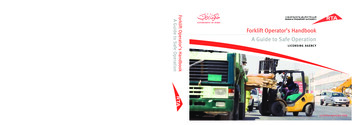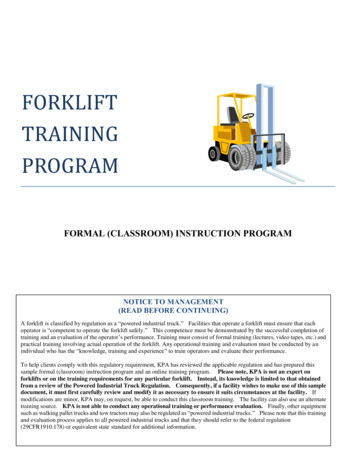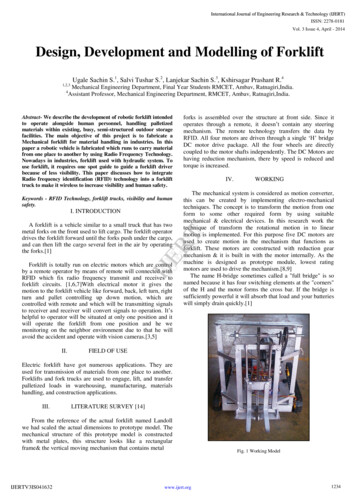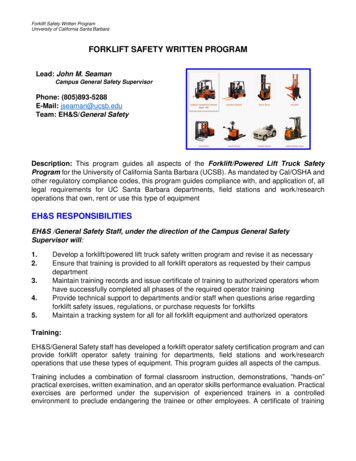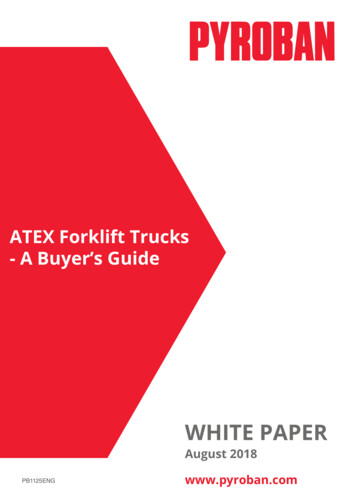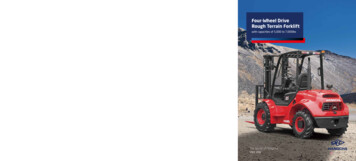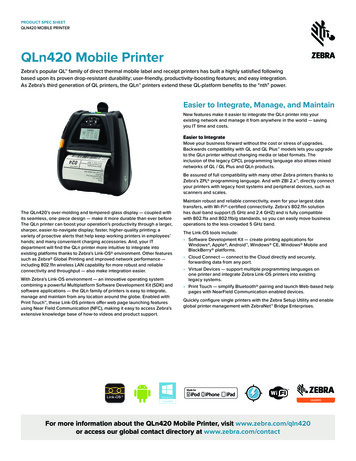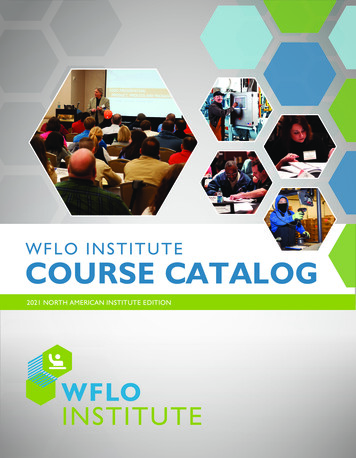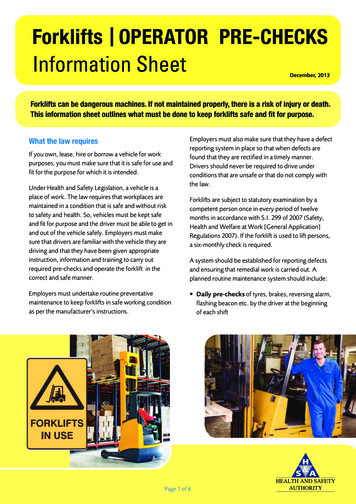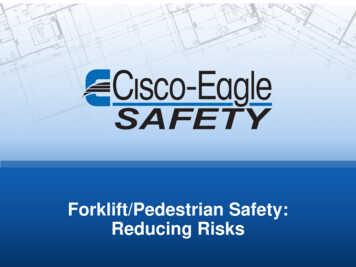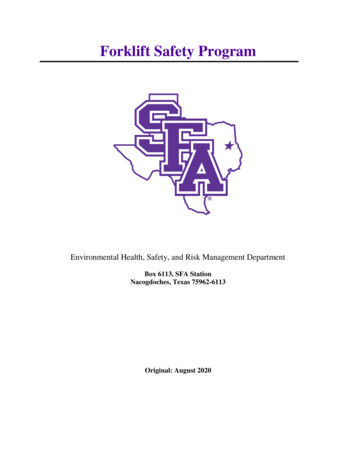
Transcription
Forklift Safety ProgramEnvironmental Health, Safety, and Risk Management DepartmentBox 6113, SFA StationNacogdoches, Texas 75962-6113Original: August 2020
I.IntroductionPowered industrial trucks, commonly called forklifts, are used on the SFA campus to movematerials. They can also be used to raise, lower, or remove large objects or a number of smallerobjects on pallets or in boxes, crates, or other containers. Forklift operators and employeesworking around these operations are at risk of hazards such as collisions, falls, tip-overs, andstruck-by accidents.The purpose of this Forklift Safety Program is to communicate safe operational practices toreduce the risk of accidents and injuries in areas where forklifts are in operation on the SFAcampus. This program has been developed in compliance with the OSHA safety standard 29CFR 1910.178. This program also establishes a documented safety training and equipmentoperator certification process to ensure all SFA employees operating a forklift have beenproperly trained in the applicable safety procedures.II.ResponsibilitiesA. Environmental Health, Safety and Risk Management (EHSRM)1. Maintain the written Forklift Safety Program,2. Retain all program records as required by SFA’s record retention policy;3. Conduct forklift safety training;4. Issue forklift operator certifications upon completion of training; and5. Periodically observe forklift operators to ensure compliance.B. Supervisors1. Be familiar with the forklift safety procedures described in this manual;2. Ensure proper maintenance and repairs to forklift equipment;3. Ensure employees or students are trained in and use proper forklift procedures;4. Notify EHSRM of any new or re-assigned employees who will need to operate a forkliftto ensure proper training and certification occurs before equipment operation. EHSRMcan be contacted through email at: safety@sfasu.edu or by calling 468-4442.5. Periodically observe forklift operators to ensure safe work practices; and6. Ensure forklift operators comply with OSHA 29 CFR 1910.178.C. Forklift Operators1. Complete the required forklift safety training program and certification process prior tooperating a forklift;2. Conduct a safety inspection of the forklift prior to each use (the checklist is provided inAppendix A on page 6 of this document);3. Use all equipment and safety features in the correct manner; and4. Notify your supervisor promptly if any maintenance or repairs are needed.2
III.Forklift Safety ProceduresA. Pre-Use Safety Inspection At the beginning of each shift, the Safety Inspection Checklist found in Appendix A onpage 6 must be completed. This pre-use inspection should be conducted at the beginningof every work shift involving the use of a forklift, and whenever a new equipmentoperator takes control of the equipment. Visual checks should also be completedthroughout the day. Any safety defects (such as hydraulic fluid leaks; defective brakes, steering, lights, horn,seat belt, or back-up alarm) must be reported to your supervisor for immediate repair. If aproblem is identified, tape the inspection checklist to the steering wheel and take the keysto your supervisor to take the forklift out of service until necessary repairs are completed.B. Operating Procedures Wear the seat belt at all times. Sound the horn and use extreme caution when meeting pedestrians making turns, turningcorners, and entering roadways. Passengers are never allowed to ride on a forklift. Arms or legs may not be placed between the uprights of the mast or outside the runninglines of the lift. Never stand or pass under any elevated portion of a forklift. Travel pathways must be maintained free from obstructions, aisles must be marked, andwide enough (six-foot minimum) for vehicle operation. Maintain sufficient headroom under overhead installations such as: lights, pipes, sprinklersystems, etc. The overhead guard must remain in place to protect against falling objects. Lift capacity must be marked on all forklifts and never exceeded. Larger loads willrequire the use of a larger forklift capable of handling the weight of the load. When a forklift is left unattended (more than 25ft. away or out of sight), the forks mustbe fully lowered, power shut off, and brakes set. Wheels must be blocked if the truck isparked on an incline. All modifications must be approved by the manufacturer, and new rated load capacitiesdetermined and posted on the truck. Written approval is required. Operators must report all accidents, regardless of fault and severity, to their supervisor.C. Loading Procedures Only handle loads within the rated capacity of the forklift. Loads should be safely arranged, stable, and centered – always use caution whenhandling loads. Forklifts equipped with attachments must be operated as a partially loaded forklift andthe weight of the attachment should be accounted for in regards to weight capacity. The forks must be placed under the load as far as possible. The mast must be carefullytilted backward to stabilize the load. Use extreme care when tilting the load forward or backward, particularly when handlingtall loads or loads that may become unstable. Tilting the forks forward while elevated isprohibited except to pick up a load.3
When stacking materials, use only enough backward tilt to stabilize the load.D. Traveling Procedures Never raise or lower a load while traveling. Slow down and sound the horn at cross aisles, pathway intersections, and other locationswhere vision is obstructed. If the load being carried obstructs forward view, the driver must travel in reverse. Loads must be tilted back and carried no more than six inches above the ground. Grades must be ascended and descended slowly. Position the load uphill relative to theoperator when ascending or descending grades. Stunt driving and horseplay are strictly prohibited.E. Fueling Procedures Fuel tanks may not be filled while the engine is running. Avoid spilling fuel. If a spilloccurs while fueling, oil or fuel must be absorbed using oil dry, cat litter, or vermiculite Any spill clean-up debris must be collected in a bucket, barrel, or other puncture resistantcontainer. Notify EHSRM at 468-4442 for proper disposal. Never operate a truck with a leak in the fuel system.F. Changing and Charging Batteries Battery charging must be located in areas designated for that purpose. Typically, the motorpool auto shop should service batteries when needed unless approvedby the department supervisor. Facilities must provided for: flushing and neutralizingspilled electrolyte, fire protection, protection of charging apparatus from damage bytrucks, adequate ventilation for dispersal of fumes from gassing batteries. Precautions must be taken to prevent open flames, sparks, or electric arcs in batterycharging areas. Employees charging and changing batteries shall be authorized to do the work, trained inthe proper handling, and required to wear protective clothing, including face shields, longsleeves, rubber boots, aprons, and gloves.IV.Training RequirementsEmployees who are authorized to operate a forklift must receive training prior to using theequipment, and at least every three (3) years thereafter. The training is to ensure that allresponsibilities and procedures described in the Forklift Safety Program are made known andunderstood. The supervisor will also ensure that authorized forklift operators have acquired thenecessary practical skills required for safe operation. Training is offered by EHSRM, andauthorized department trainers. Department trainers must be approved by EHSRM and beexperienced operators who have the knowledge, training, and skills necessary to evaluate thecompetence of operators. Training will consist of a combination of classroom safety instruction,hands-on training, and evaluation of the operator's performance in the workplace.A. Initial TrainingThe initial training will consist of the following information: Complete instruction on the safety procedures described in this program.4
Intended purpose and function of each control.Prior to operating any forklift, the trainee will receive training by a qualified person onthe contents of the manufacturer's operating instruction(s) and this safety program.The forklift’s operating limitations and restrictions as defined by the manufacturer.Explanation of all controls, decals, warnings, and instructions displayed on the forklift.All training and evaluation must be completed before an operator is permitted to use aforklift without supervision. An operator certification card will be issued by EHSRMupon successful completion of the training.B. Refresher TrainingRefresher training will be conducted every three years or after an accident or injury involving aforklift. The refresher training will include: Review of the Pre-Use Safety Inspection form. Review of manufacturer’s weight capacity and specifications. Review of all safety procedures outlined in this program. Updated information on new equipment as needed.C. Annual EvaluationsThe Safety Department will conduct annual evaluations of this safety program and notifysupervisors and forklift operators if any changes or updates are made. Additionally, the SafetyOfficer (in conjunction with department supervisors) will evaluate equipment, safety devices,and operator performance. Retraining will be conducted if needed.Any training conducted by an authorized department trainer must be documented and emailed toEHSRM at safety@sfasu.edu or campus mail Box 6113. An operator certification card will thenbe issued.For any questions or concerns related to the safe operation of forklifts on the SFA campus,contact EHSRM at 468-4442 or email: safety@sfasu.edu.5
Appendix AForklift Safety Inspection ChecklistCheck each item before using the forklift each day. Put a check in the box if the item is OK.Explain any unchecked items in writing at the bottom of this form and immediately report themto your supervisor.Do not use an unsafe forklift. Your safety is at risk! If a problem is identified affecting the safetyof the forklift, tape this checklist to the steering wheel and take the keys to your supervisor totake the forklift out of service until proper repairs have been made.Forklift Model or Identification Number:Operator Name:Hour Meter Reading: Date:Visual CheckTires are inflated and free of excessive wear or damage.Forks & Mast are not bent or cracked.Load Back Rest is in place and not bent, cracked, or loose.Overhead Guard is in place and not bent, cracked, or loose.Attachments (if equipped) function properly and are not damaged.Forklift Body is not damaged and is free of excessive grease or oil.Engine Oil is full and free of leaks.Hydraulic Oil is full and free of leaks.Radiator is full and free of leaks.Fuel Level is OK and free of leaks.Battery Connections are tight.Covers over the battery and other hazardous parts are in place and secure.Load Rating Plate is present and readable.Warning Decals are present and readable.Seat Belt is accessible and not damaged.Engine runs smooth and quiet.Horn works.Turn Signal (if equipped) operates correctly.Lights (head, tail, & warning) work properly.Gauges & Instruments are working.Lift & Lower operates smoothly without excessive drift.Tilt operates smoothly without excessive drift or “chatter”.Control Levers are labeled, not loose or binding, and freely return to neutral.Steering is smooth, responsive, and free of excessive play.Brakes work and function smoothly without grabbing. No fluid leaks.Parking Brake is tight and will hold the forklift on an incline.Backup Alarm (if equipped) works.6
1. Complete the required forklift safety training program and certification process prior to operating a forklift; 2. Conduct a safety inspection of the forklift prior to each use (the checklist is provided in Appendix A on page 6 of this document); 3. Use all equipment and safety features in the correct manner; and 4.
